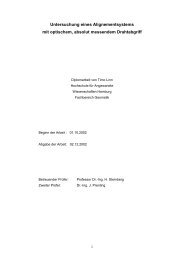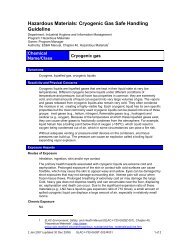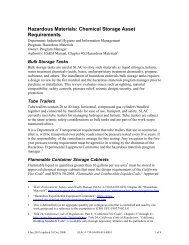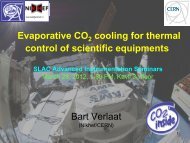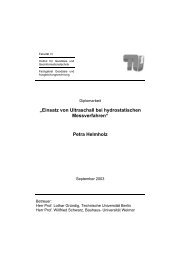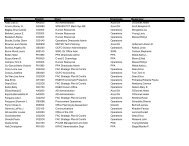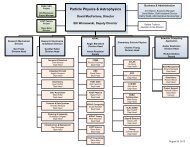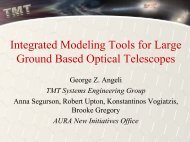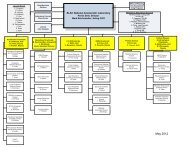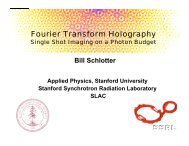BES - SLAC Group/Department Public Websites - Stanford University
BES - SLAC Group/Department Public Websites - Stanford University
BES - SLAC Group/Department Public Websites - Stanford University
You also want an ePaper? Increase the reach of your titles
YUMPU automatically turns print PDFs into web optimized ePapers that Google loves.
FYO7 <strong>SLAC</strong> S CIENCE AND T ECHNOLOGY S ELF E VALUATION<br />
Objective 1.2 Leadership in Science and Technology<br />
Awards<br />
Mark Hogan elected to APS Fellow (December 2006).<br />
<strong>Public</strong>ations<br />
The following are included in the <strong>Public</strong>ations Appendix. Unreviewed publications are included in<br />
the Spires database.<br />
Peer Reviewed <strong>Public</strong>ations: 3<br />
Student Theses: 1 PhD<br />
Invited Presentations: 7<br />
HEP Community Leadership<br />
Hogan, Mark<br />
Organizing Committee for the Advanced Accelerator Concepts Workshop (2006, 2008).<br />
Technical consultant for the BNL DOE HEP Program review (2006-2007).<br />
Ischebeck, Rasmus<br />
Working <strong>Group</strong> Leader, Beam Driven Concepts, Advanced Accelerator Concepts<br />
Workshop 2006.<br />
Objective 1.3 Provide and sustain Science and Technology Outputs that Advance Program Objectives and<br />
Goals<br />
E-167 has a strong publication and presentation history with an additional large educational<br />
component (one PhD completed and three PhDs in progress).<br />
Objective 1.4 Provide for Effective Delivery of Science and Technology<br />
Consistently good reviews: <strong>SLAC</strong> DOE HEP Program review; the <strong>SLAC</strong> Scientific Policy<br />
Committee and the Experimental Program Advisory Committee.<br />
Attracts world class researchers and students to the collaboration while providing trendsetting<br />
work in the advanced accelerator field.<br />
Invited talks annually at PAC, APS, AAC and other venues.<br />
NLCTA and E-163<br />
R&D conducted at the NLCTA leads the world in (1) high-gradient rf (HGRF) technology at X-band<br />
and (2) laser-driven structure-based acceleration. Work directly supports DOE’s accelerator-based<br />
high energy physics mission by developing techniques to be used to build future accelerators.<br />
Techniques and apparatus for high-power rf device conditioning and characterization are sought out<br />
by users the world over.<br />
Novel approaches to acceleration with microwave and laser radiation are being pursued, leading to<br />
new rf pulse power components, and new optical devices. Selection of 12 GHz technology by CERN<br />
for the next-generation linear collider (CLIC) provides strong evidence that the long-term investment<br />
in high-frequency rf technology will pay off. Collaborators from CERN and Russia come to the<br />
NLCTA to use its unique facilities. Staff members are leaders in their fields.<br />
The development of a new class of electro-optic devices to use laser light to accelerate electrons is<br />
unique in the world and has already led to world-leading demonstrations of two new acceleration<br />
mechanisms, and high-sensitivity high-precision techniques for diagnosing micron- and femtosecondclass<br />
beams. Collaboration is interdisciplinary and the members are leaders in their respective fields.<br />
X-band structures sent for test have been successfully tested and characterized. Preparatory work for<br />
rf switch testing was completed. Construction of the experimental apparatus for conducting laserdriven<br />
acceleration experiments was completed, and the new beam line and experiment were<br />
successfully commissioned and used in scientific experiments.<br />
Work conducted at the NLCTA was featured in 3 invited talks, and 14 papers (4 refereed). Both the<br />
F I N A L P A G E 4 7



